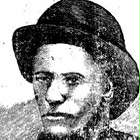
d: 1878
Joseph LaPage
Summary
Name:
Nickname:
The French Monster / La Pagette / Paige / Parrish / Paize / Le PaizeYears Active:
1867 - 1875Status:
ExecutedClass:
Serial KillerVictims:
4Method:
Strangulation / Decapitation / Bludgeoning / Mutilation / NecrophiliaDeath:
March 15, 1878Nationality:
Canada
d: 1878
Joseph LaPage
Summary: Serial Killer
Name:
Joseph LaPageNickname:
The French Monster / La Pagette / Paige / Parrish / Paize / Le PaizeStatus:
ExecutedVictims:
4Method:
Strangulation / Decapitation / Bludgeoning / Mutilation / NecrophiliaNationality:
CanadaDeath:
March 15, 1878Years Active:
1867 - 1875bio
Joseph LaPage, born Joseph Paget in 1838 in a remote settlement approximately 50 miles northwest of Montreal, grew up as the son of French immigrant farmers who were well respected in their community. At around age 20, he married a woman three years his senior. The couple went on to have five children. Roughly five years into their marriage, the family relocated to Sainte‑Béatrix. It was there that darker aspects of LaPage’s personality began to emerge. Locals whispered of his volatile nature—he habitually abused his wife and eldest daughter. At one harrowing moment, he nearly murdered his sister-in-law, Julienne Rousse, who survived and later came forward to testify against him at his trial.
When authorities attempted to arrest him, LaPage resisted violently—he knocked the arresting officer to the ground and fled across the border into the United States. He didn’t leave his family behind; they accompanied him as he settled in St. Albans, Vermont, around September of 1871. But the black cloud over his reputation followed. A year later, LaPage briefly returned to his former stomping grounds in Canada. There, he was suspected of setting fire to the house of a man connected to his earlier arrest. He also attacked a young, unmarried woman—striking her with a club so severely that her injuries lingered for a month. His abusiveness extended toward children as well: he attempted to lure a 14-year-old girl into the woods, though luckily, she escaped. Shaken, he returned to St. Albans, finding work intermittently as a farmhand and woodsman.
murder story
On a fateful summer day—July 24, 1874—in proximity to where he worked, LaPage’s obsession found a target in Mariette N. Ball, a schoolteacher whose routine path to Foster A. Page’s home brought her through a field where LaPage labored. Obsessed and calculating, he pretended to go berry-picking, slipped through the woods, and waited atop a hill. He donned a crude mask made from an old mat and ambushed Ball. She fought fiercely—ripping the mask and scratching his face—but was ultimately strangled to death. In a grotesque act, LaPage engaged in necrophilia, then smashed her skull against a stone to ensure she stayed dead before fleeing the scene in shockingly calm aftermath.
When Ball’s body was discovered, local law enforcement sprung into action. LaPage was temporarily detained—his scratched face aroused suspicion, and he had asked about the train departure to George M. Lang. Sheriffs Newton and Swift questioned him, even a detective from Boston weighed in—but without concrete evidence, LaPage walked free. The case went cold, and the Ball family eventually relocated to California in the wake of the crime.
Sometime after Ball’s killing, LaPage relocated to Suncook, New Hampshire, hired as a substitute tender by the Fowler family. He set his sights on a girl passing through—asking Mr. Fowler’s son about her identity and route. The boy told him the girl was his sister, Josie Langmaid. Armed with this information, LaPage hid himself near the old road, waiting until the morning of October 4, 1875. When Josie, aged 17, passed by on her way to school, LaPage ambushed her. In a horrifying sequence, he ripped her clothes, raped her, beat her with a stick, and used a knife to cut her throat deeply—decapitating her in the process.
Even after death, LaPage continued his desecration. He transported her head elsewhere, returned to the crime scene to wash his hands, coat, and knife in a brook, then hid her wallet, ring, and other belongings. To erase his traces, he burned his clothes at home. When his wife questioned the scratches on his neck, he blamed poison ivy.
When Josie’s mutilated body was discovered, the town was horrified. Bill Drew, a local man, was almost lynched by a frenzied mob. Thankfully, Mr. Fowler’s son remembered LaPage’s suspicious questions and tipped off authorities. Mr. W. N. Abell—who once housed Mariette Ball—recognized LaPage’s link to the earlier murder.
LaPage was arrested soon after, thanks to suspicious behavior, eyewitness recollections, and connections to the earlier murder of Mariette Ball. At his initial trial, he was found guilty and sentenced to death, but the verdict was overturned upon appeal for being “unfair,” leading to a second trial in which he was again convicted and sentenced to hang.
In the days leading up to his execution, LaPage was confined to an isolated cell. Eyewitnesses noted how he paced gloomily, repeatedly whispered prayers, and stared out the window. Reporters and religious officials visited, during which he confessed—“I kill gal. Yes, I kill two gal. Too bad, too bad.” Unable to read in either English or French, he marked March 15, 1878 on a calendar, the day of his hanging.
On the day of execution, Sheriff Dodge and deputies escorted LaPage to the scaffold. He was accompanied by Fathers Barret and Millett, who prayed solemnly in French. Despite the gravity of the moment, LaPage remained calm. After the death warrant was read, the sheriff intoned:
LaPage descended through the trapdoor—about six feet—with no visible convulsions or final kick; he died quietly. At his wife's request, his body was buried in the cemetery behind Suncook’s Catholic church.